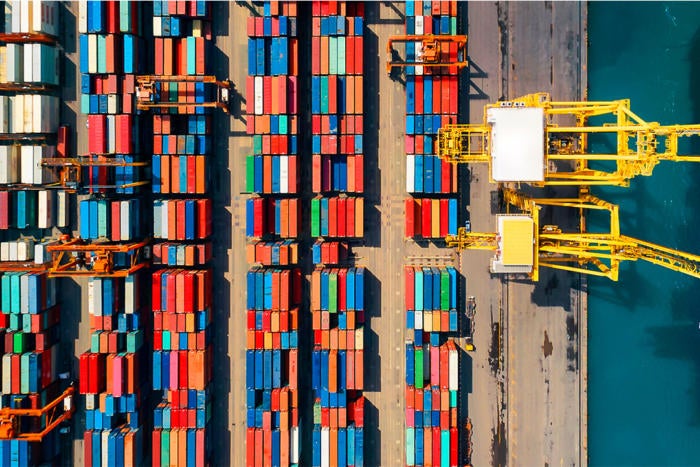IBM, Maersk launch blockchain-based shipping platform with 94 early adopters

Credit to Author: Lucas Mearian| Date: Fri, 17 Aug 2018 08:51:00 -0700
After launching a proof of concept earlier this year, IBM and Maersk have unveiled TradeLens, the production version of an electronic ledger for tracking global shipments; the companies say they have 94 participants piloting the system, including more than 20 port and terminal operators.
The jointly developed electronic shipping ledger records details of cargo shipments as they leave their origin, arrive in ports, are shipped overseas and eventually received.
During the transportation process, all of the involved parties in the supply chain can view tracking information such as shipment arrival times and documents such as customs releases, commercial invoices and bills of lading in near real time via the permissioned blockchain ledger.
More than 160 million such shipping events have been captured on the platform, according to IBM and Maersk. “This data is growing at a rate of close to one million events per day,” the companies said.
Shipping containers arrive in a port terminal.
Traditionally, the international shipping industry’s information systems have used paper legal documents, and electronic data was transmitted via electronic data interchange (EDI) – a 60-year-old technology that doesn’t represent real-time data information.
Shipping participants have also shared documents via email, fax and courier.
When information is entered or scanned in manually, TradeLens can track critical data about every shipment in a supply chain, and it offers an immutable record among all parties involved, the companies said.
Some shipping manifests can also be moved via an API to the TradeLens platform, so that manufacturers and others in the supply chain have more timely information and improved visibility to the process.
Along with freight forwarders, transportation companies and logistics firms, more than 20 port and terminal operators are using or have agreed to pilot TradeLens, including PSA Singapore, International Container Terminal Services Inc., Patrick Terminals and Modern Terminals Ltd. in Hong Kong. Customs authorities in the Netherlands, Saudi Arabia, Singapore, Australia and Peru are also participating.
Containers are offloaded from ships and stored in port terminals before being move by truck or railroad to final destinations.
“This accounts for approximately 234 marine gateways worldwide that have or will be actively participating on TradeLens,” IBM said.
Hong Kong-based Modern Terminals became a beta partner of the TradeLens blockchain earlier this year.
“Digitized documentation that can at the same time be authenticated will drive down costs and increase supply chain security,” Modern Terminals CEO Peter Levesque said via email.
As a port operator, Modern Terminals doesn’t have a need to track shipments outside of its operating environment, but it keeps the status of containers coming in and out of its terminals via a Terminal Operating System (TOS), many of which utilize EDI and wireless LANs and Radio-frequency identification (RFID) to monitor cargo movements. The company handles about 5.5 million shipping containers per year at its Hong Kong business unit.
Shipping containers leave a port via railroad.
The documentation that accompanies a container of cargo from the factory floor to store shelf is cumbersome and open, Levesque said. A blockchain-based electronic ledger will provide a platform where all the documentation along the way can be viewed and updated in near real time and in a secure environment by authorized supply chain participants.
It will also give customs, commerce, and border patrol agents around the world “a higher degree of certainty about what’s in the box, and who loaded it,” Levesque added.
“Modern Terminals plans to be a regular user of the solution once full development and testing are complete,” Levesque said. “We’ve only begun to scratch the surface on what we can use blockchain technology for in the transportation and logistics industry. Tackling the opportunity for improving the transmission of documents around the world is a great beginning. The next decade of development will be exciting to watch.”